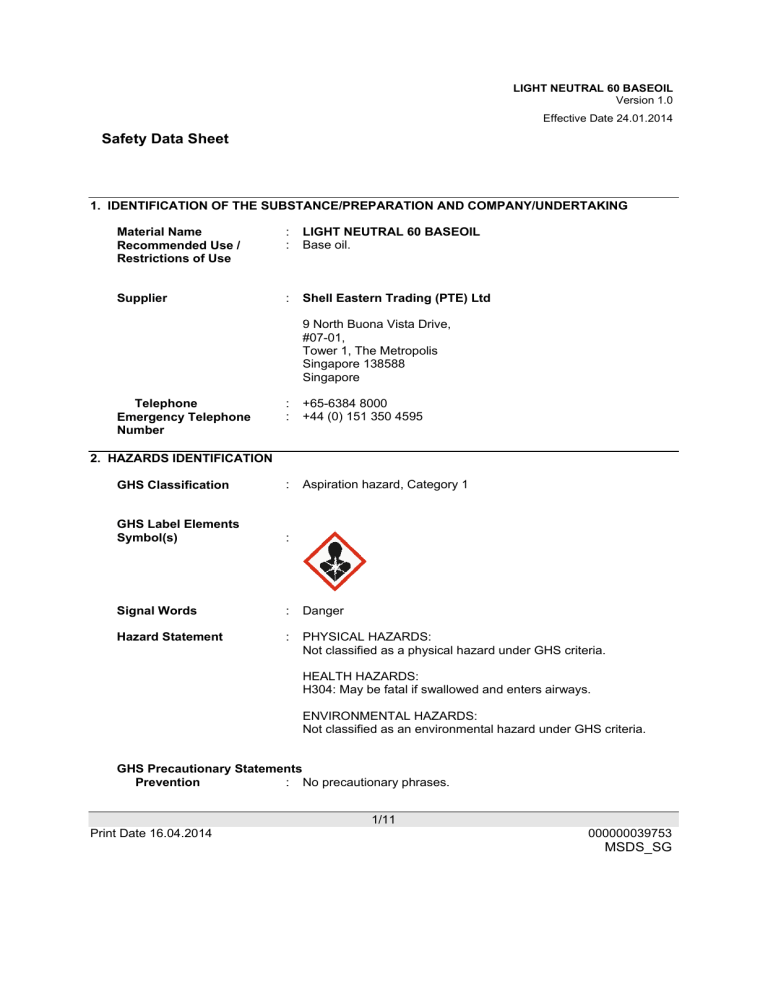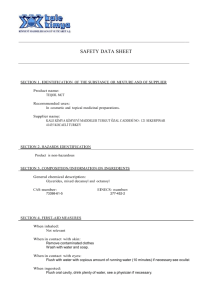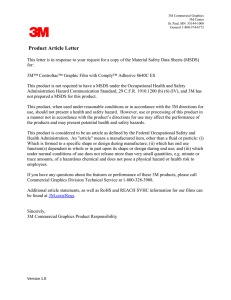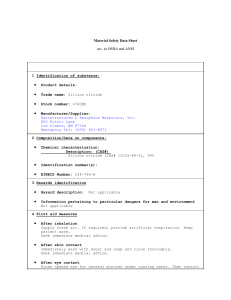Safety Data Sheet

LIGHT NEUTRAL 60 BASEOIL
Version 1.0
Effective Date 24.01.2014
Safety Data Sheet
1. IDENTIFICATION OF THE SUBSTANCE/PREPARATION AND COMPANY/UNDERTAKING
Material Name
Recommended Use /
Restrictions of Use
Supplier
: LIGHT NEUTRAL 60 BASEOIL
: Base oil.
: Shell Eastern Trading (PTE) Ltd
9 North Buona Vista Drive,
#07-01,
Tower 1, The Metropolis
Singapore 138588
Singapore
Telephone
Emergency Telephone
Number
: +65-6384 8000
: +44 (0) 151 350 4595
2. HAZARDS IDENTIFICATION
GHS Classification : Aspiration hazard, Category 1
GHS Label Elements
Symbol(s) :
Signal Words
Hazard Statement
: Danger
: PHYSICAL HAZARDS:
Not classified as a physical hazard under GHS criteria.
HEALTH HAZARDS:
H304: May be fatal if swallowed and enters airways.
ENVIRONMENTAL HAZARDS:
Not classified as an environmental hazard under GHS criteria.
GHS Precautionary Statements
Prevention
1/11
Print Date 16.04.2014
000000039753
MSDS_SG
LIGHT NEUTRAL 60 BASEOIL
Version 1.0
Effective Date 24.01.2014
Safety Data Sheet
Response
Storage
Disposal:
: P301+P310: IF SWALLOWED: Immediately call a POISON
CENTER or doctor/physician.
P331: Do NOT induce vomiting.
: P405: Store locked up.
: P501: Dispose of contents and container to appropriate waste site or reclaimer in accordance with local and national regulations.
Other Hazards which do not result in classification
: Not classified as flammable but will burn.
Repeated exposure may cause skin dryness or cracking. Used oil may contain harmful impurities.
3. COMPOSITION/INFORMATION ON INGREDIENTS
Mixture Description
CAS No.
: Highly refined mineral oil.
: 64742-53-6
Classification of components according to GHS
Chemical Identity Synonyms CAS Hazard Class
(category)
Hazard
Statement
64742-53-6 Asp. Tox., 1; H304; Distillates
(petroleum), hydrotreated light naphthenic
Additional Information : extract, according to IP346.
Conc.
100.00 %
The highly refined mineral oil contains <3% (w/w) DMSO-
Refer to Ch 16 for full text of H phrases.
4. FIRST-AID MEASURES
Inhalation
Skin Contact
Eye Contact
Ingestion
Print Date 16.04.2014
: No treatment necessary under normal conditions of use. If symptoms persist, obtain medical advice.
: Remove contaminated clothing. Flush exposed area with water and follow by washing with soap if available. If persistent irritation occurs, obtain medical attention.
: Flush eye with copious quantities of water. If persistent irritation occurs, obtain medical attention.
: If swallowed, do not induce vomiting: transport to nearest
2/11
000000039753
MSDS_SG
LIGHT NEUTRAL 60 BASEOIL
Version 1.0
Effective Date 24.01.2014
Safety Data Sheet
Most Important
Symptoms/Effects, Acute
& Delayed medical facility for additional treatment. If vomiting occurs spontaneously, keep head below hips to prevent aspiration. If any of the following delayed signs and symptoms appear within the next 6 hours, transport to the nearest medical facility: fever greater than 101° F (38.3°C), shortness of breath, chest congestion or continued coughing or wheezing. Give nothing by mouth.
: If material enters lungs, signs and symptoms may include coughing, choking, wheezing, difficulty in breathing, chest congestion, shortness of breath, and/or fever.
The onset of respiratory symptoms may be delayed for several hours after exposure.
Oil acne/folliculitis signs and symptoms may include formation of black pustules and spots on the skin of exposed areas.
Ingestion may result in nausea, vomiting and/or diarrhoea.
: Treat symptomatically. Immediate medical attention, special treatment
5. FIRE-FIGHTING MEASURES
Clear fire area of all non-emergency personnel.
Specific hazards arising from Chemicals
: Hazardous combustion products may include: A complex mixture of airborne solid and liquid particulates and gases
(smoke). Carbon monoxide may be evolved if incomplete combustion occurs. Unidentified organic and inorganic compounds.
Suitable Extinguishing
Media
Unsuitable Extinguishing
Media
Protective Equipment &
Precautions for Fire
Fighters
: Foam, water spray or fog. Dry chemical powder, carbon dioxide, sand or earth may be used for small fires only.
: Do not use water in a jet.
: Proper protective equipment including breathing apparatus must be worn when approaching a fire in a confined space.
6. ACCIDENTAL RELEASE MEASURES
Avoid contact with spilled or released material. For guidance on selection of personal protective equipment see Chapter 8 of this Material Safety Data Sheet.
See Chapter 13 for information on disposal.
Observe the relevant local and international regulations.
Personal Precautions, : Avoid contact with skin and eyes.
3/11
Print Date 16.04.2014
000000039753
MSDS_SG
LIGHT NEUTRAL 60 BASEOIL
Version 1.0
Effective Date 24.01.2014
Safety Data Sheet
Protective Equipment and
Emergency Procedures
Environmental
Precautions
Methods and Material for
Containment and
Cleaning Up
Additional Advice
: Use appropriate containment to avoid environmental contamination. Prevent from spreading or entering drains, ditches or rivers by using sand, earth, or other appropriate barriers.
: Slippery when spilt. Avoid accidents, clean up immediately.
Prevent from spreading by making a barrier with sand, earth or other containment material. Reclaim liquid directly or in an absorbent. Soak up residue with an absorbent such as clay, sand or other suitable material and dispose of properly.
: Local authorities should be advised if significant spillages cannot be contained.
7. HANDLING AND STORAGE
General Precautions
Precautions for Safe
Handling
: Use local exhaust ventilation if there is risk of inhalation of vapours, mists or aerosols.
Use the information in this data sheet as input to a risk assessment of local circumstances to help determine appropriate controls for safe handling, storage and disposal of this material.
: Avoid prolonged or repeated contact with skin.
Avoid inhaling vapour and/or mists.
When handling product in drums, safety footwear should be worn and proper handling equipment should be used.
Properly dispose of any contaminated rags or cleaning materials in order to prevent fires.
Conditions for Safe
Storage
Product Transfer
: Keep container tightly closed and in a cool, well-ventilated place.
Use properly labelled and closeable containers.
Store at ambient temperature.
: This material has the potential to be a static accumulator.
Proper grounding and bonding procedures should be used during all bulk transfer operations.
Recommended Materials : For containers or container linings, use mild steel or high
Unsuitable Materials
Other Advice density polyethylene.
: PVC.
: Polyethylene containers should not be exposed to high temperatures because of possible risk of distortion.
8. EXPOSURE CONTROLS/PERSONAL PROTECTION
If the American Conference of Governmental Industrial Hygienists (ACGIH) value is provided on this document, it is provided for information only.
4/11
Print Date 16.04.2014
000000039753
MSDS_SG
LIGHT NEUTRAL 60 BASEOIL
Version 1.0
Effective Date 24.01.2014
Safety Data Sheet
Occupational Exposure Limits
Oil mist, mineral ACGIH TWA(Inhala ble fraction.)
5 mg/m3
SG OEL
SG OEL
TWA(Mist.)
STEL(Mist.)
5 mg/m3
10 mg/m3
Biological Exposure Index (BEI)
No biological limit allocated.
Appropriate Engineering
Controls
: The level of protection and types of controls necessary will vary depending upon potential exposure conditions. Select controls based on a risk assessment of local circumstances.
Appropriate measures include: Adequate ventilation to control airborne concentrations.
Where material is heated, sprayed or mist formed, there is greater potential for airborne concentrations to be generated.
Define procedures for safe handling and maintenance of controls.
Educate and train workers in the hazards and control measures relevant to normal activities associated with this product.
Ensure appropriate selection, testing and maintenance of equipment used to control exposure, e.g. personal protective equipment, local exhaust ventilation.
Drain down system prior to equipment break-in or maintenance.
Retain drain downs in sealed storage pending disposal or for subsequent recycle.
Always observe good personal hygiene measures, such as washing hands after handling the material and before eating, drinking, and/or smoking. Routinely wash work clothing and protective equipment to remove contaminants. Discard contaminated clothing and footwear that cannot be cleaned. Practice good housekeeping.
Individual Protection
Measures
: Personal protective equipment (PPE) should meet recommended national standards. Check with PPE suppliers.
Respiratory Protection : No respiratory protection is ordinarily required under normal conditions of use.
In accordance with good industrial hygiene practices, precautions should be taken to avoid breathing of material.
If engineering controls do not maintain airborne concentrations to a level which is adequate to protect worker
5/11
Print Date 16.04.2014
000000039753
MSDS_SG
Safety Data Sheet
LIGHT NEUTRAL 60 BASEOIL
Version 1.0
Effective Date 24.01.2014
Hand Protection
Eye Protection
Protective Clothing
Thermal Hazards
Monitoring Methods
Print Date 16.04.2014
health, select respiratory protection equipment suitable for the specific conditions of use and meeting relevant legislation.
Check with respiratory protective equipment suppliers.
Where air-filtering respirators are suitable, select an appropriate combination of mask and filter.
Select a filter suitable for combined particulate/organic gases and vapours [boiling point
>65°C(149 °F)].
: Where hand contact with the product may occur the use of gloves approved to relevant standards (e.g. Europe: EN374,
US: F739) made from the following materials may provide suitable chemical protection: PVC, neoprene or nitrile rubber gloves.
Suitability and durability of a glove is dependent on usage, e.g. frequency and duration of contact, chemical resistance of glove material, dexterity. Always seek advice from glove suppliers. Contaminated gloves should be replaced.
Personal hygiene is a key element of effective hand care.
Gloves must only be worn on clean hands. After using gloves, hands should be washed and dried thoroughly. Application of a non-perfumed moisturizer is recommended.
For continuous contact we recommend gloves with breakthrough time of more than 240 minutes with preference for > 480 minutes where suitable gloves can be identified. For short-term/splash protection we recommend the same, but recognise that suitable gloves offering this level of protection may not be available and in this case a lower breakthrough time may be acceptable so long as appropriate maintenance and replacement regimes are followed.
Glove thickness is not a good predictor of glove resistance to a chemical as it is dependent on the exact composition of the glove material.
Glove thickness should be typically greater than 0.35 mm depending on the glove make and model.
: Wear safety glasses or full face shield if splashes are likely to occur.
: Skin protection is not required under normal conditions of use.
It is good practice to wear chemical resistant gloves.
: Not applicable.
: Monitoring of the concentration of substances in the breathing zone of workers or in the general workplace may be required to confirm compliance with an OEL and adequacy of exposure controls. For some substances biological monitoring may also be appropriate.
Validated exposure measurement methods should be applied by a competent person and samples analysed by an accredited laboratory.
Examples of sources of recommended exposure measurement methods are given below or contact the supplier. Further national methods may be available.
6/11
000000039753
MSDS_SG
LIGHT NEUTRAL 60 BASEOIL
Version 1.0
Effective Date 24.01.2014
Safety Data Sheet
Environmental Exposure
Controls
National Institute of Occupational Safety and Health (NIOSH),
USA: Manual of Analytical Methods http://www.cdc.gov/niosh/
Occupational Safety and Health Administration (OSHA), USA:
Sampling and Analytical Methods http://www.osha.gov/
Health and Safety Executive (HSE), UK: Methods for the
Determination of Hazardous Substances http://www.hse.gov.uk/
Institut für Arbeitsschutz Deutschen Gesetzlichen
Unfallversicherung (IFA), Germany. http://www.dguv.de/inhalt/index.jsp
L'Institut National de Recherche et de Securité, (INRS), France http://www.inrs.fr/accueil
: Local guidelines on emission limits for volatile substances must be observed for the discharge of exhaust air containing vapour.
Take appropriate measures to fulfil the requirements of relevant environmental protection legislation. Avoid contamination of the environment by following advice given in
Chapter 6. If necessary, prevent undissolved material from being discharged to waste water. Waste water should be treated in a municipal or industrial waste water treatment plant before discharge to surface water.
9. PHYSICAL AND CHEMICAL PROPERTIES
Appearance
Odour
Odour threshold pH
Initial Boiling Point and
Boiling Range
Pour point
: Amber.
Liquid at room temperature.
: Slight
: Data not available
: Not
: > 280 °C / 536 °F estimated value(s)
Flash point
Upper / lower
Vapour pressure
Relative Density
: Data not available
: 146 °C
: Typical
/ 295 °F
1 - 10 %(V)
Flammability or
Explosion limits
Auto-ignition temperature : > 320 °C / 608 °F
(based on mineral oil)
: < 0.5 Pa at 20 °C / 68 °F (estimated value(s))
: 0.895
at 15 °C / 59 °F
Density
Water solubility
Solubility in other
: 895 at 15 °C / 59 °F
: Negligible.
: Data not available solvents n-octanol/water partition coefficient (log Pow)
: > 6 (based on information on similar products)
7/11
Print Date 16.04.2014
000000039753
MSDS_SG
LIGHT NEUTRAL 60 BASEOIL
Version 1.0
Effective Date 24.01.2014
Safety Data Sheet
Dynamic viscosity
Kinematic viscosity
Vapour density (air=1)
Evaporation rate
(nBuAc=1)
Decomposition
Temperature
Flammability
: Data not available
: Data not available
: 10.0 - 15 mm2/s at 40 °C / 104 °F
: > 1 (estimated value(s))
: Data not available
: Data not available
10. STABILITY AND REACTIVITY
Chemical stability
Possibility of Hazardous
Reactions
Conditions to Avoid
Incompatible Materials
Hazardous
Decomposition Products
: Stable.
: Reacts with strong oxidising agents.
: Extremes of temperature and direct sunlight.
: Strong oxidising agents.
: Hazardous decomposition products are not expected to form during normal storage.
11. TOXICOLOGICAL INFORMATION
Information on Toxicological effects
Basis for Assessment
Likely Routes of
Exposure
Acute Oral Toxicity
: Information given is based on data on the components and the toxicology of similar products.
: Skin and eye contact are the primary routes of exposure although exposure may occur following accidental ingestion.
: Low LD50 > 5000 mg/kg , Rat
: Low LD50 > 5000 mg/kg , Rabbit Acute Dermal Toxicity
Acute Inhalation Toxicity : Low LC50 >5 mg/l , 4 h, Rat
Skin corrosion/irritation
Serious eye damage/irritation
Respiratory Irritation
: Expected to be slightly irritating.
Prolonged/repeated contact may cause defatting of the skin which can lead to dermatitis.
: Expected to be slightly irritating.
Respiratory or skin sensitisation
Aspiration Hazard
: Inhalation of vapours or mists may cause irritation.
: Not expected to be a skin sensitiser.
: Aspiration into the lungs when swallowed or vomited may
Germ cell mutagenicity cause chemical pneumonitis which can be fatal.
: Not expected to be mutagenic.
8/11
Print Date 16.04.2014
000000039753
MSDS_SG
LIGHT NEUTRAL 60 BASEOIL
Version 1.0
Effective Date 24.01.2014
Safety Data Sheet
Carcinogenicity : Not expected to be carcinogenic.
Product contains mineral oils of types shown to be non-carcinogenic in animal skin-painting studies.
Highly refined mineral oils are not classified as carcinogenic by the International Agency for Research on
Cancer (IARC).
Material
Highly refined mineral oil
(IP346 <3%)
Highly refined mineral oil
(IP346 <3%)
Highly refined mineral oil
(IP346 <3%)
:
:
:
Carcinogenicity Classification
ACGIH Group A4: Not classifiable as a human carcinogen.
IARC 3: Not classifiable as to carcinogenicity to humans.
: GHS CLP : No carcinogenicity classification
Reproductive and
Developmental Toxicity
Specific target organ toxicity - repeated exposure
Additional Information
: Not expected to be a hazard.
: Not expected to be a hazard.
: Used oils may contain harmful impurities that have accumulated during use. The concentration of such impurities will depend on use and they may present risks to health and the environment on disposal. ALL used oil should be handled with caution and skin contact avoided as far as possible.
12. ECOLOGICAL INFORMATION
Basis for Assessment : Ecotoxicological data have not been determined specifically for this product.
Information given is based on a knowledge of the
Acute Toxicity components and the ecotoxicology of similar products.
: Poorly soluble mixture. May cause physical fouling of aquatic organisms. Practically non toxic: LL/EL/IL50 > 100 mg/l (to aquatic organisms) LL/EL50 expressed as the nominal amount of product required to prepare aqueous test extract. Mineral oil
Microorganisms
Mobility is not expected to cause any chronic effects to aquatic organisms at concentrations less than 1 mg/l.
: Practically non toxic: LC/EC/IC50 > 100 mg/l
: Liquid under most environmental conditions.
If it enters soil, it will adsorb to soil particles and will not be mobile.
Floats on water.
9/11
Print Date 16.04.2014
000000039753
MSDS_SG
LIGHT NEUTRAL 60 BASEOIL
Version 1.0
Effective Date 24.01.2014
Safety Data Sheet
Persistence/degradability : Major constituents are expected to be readily biodegradable,
Bioaccumulative
Potential but the product contains components that may persist in the environment.
: Contains components with the potential to bioaccumulate.
Other Adverse Effects : Product is a mixture of non-volatile components, which are not expected to be released to air in any significant quantities.
expected to have ozone depletion potential, photochemical ozone creation potential or global warming potential.
Not
13. DISPOSAL CONSIDERATIONS
Material Disposal : Recover or recycle if possible.
It is the responsibility of the waste generator to determine the toxicity and physical
Container Disposal
Local Legislation properties of the material generated to determine the proper waste classification and disposal methods in compliance with applicable regulations.
Do not dispose into the environment, in drains or in water courses.
: Dispose in accordance with prevailing regulations, preferably to a recognised collector or contractor. The competence of the collector or contractor should be established beforehand.
: Disposal should be in accordance with applicable regional, national, and local laws and regulations.
14. TRANSPORT INFORMATION
Land (as per ADR classification): Not regulated
This material is not classified as dangerous under ADR regulations.
IMDG
This material is not classified as dangerous under IMDG regulations.
IATA (Country variations may apply)
This material is either not classified as dangerous under IATA regulations or needs to follow country specific requirements.
Transport in bulk according to Annex II of MARPOL 73/78 and the IBC Code
Pollution Category : Not applicable.
Ship Type
Product Name
Special Precaution
Additional Information
: Not applicable.
: Not applicable.
: Not applicable.
: MARPOL Annex 1 rules apply for bulk shipments by sea.
10/11
Print Date 16.04.2014
000000039753
MSDS_SG
LIGHT NEUTRAL 60 BASEOIL
Version 1.0
Effective Date 24.01.2014
Safety Data Sheet
15. REGULATORY INFORMATION
The regulatory information is not intended to be comprehensive. Other regulations may apply to this material.
Chemical Inventory Status
EINECS : All components listed or polymer exempt.
TSCA : All components listed.
Other Information : Environmental Protection and Management Act. Workplace
Safety and Health Act 2006.
16. OTHER INFORMATION
Hazard Statement
H304 May be fatal if swallowed and enters airways.
SDS Version Number
SDS Effective Date
SDS Revisions
: 1.0
: 24.01.2014
: A vertical bar (|) in the left margin indicates an amendment from the previous version.
: The information in this document should be made available to SDS Distribution all who may handle the product.
Key Literature References : The quoted data are from, but not limited to, one or more sources of information (e.g. toxicological data from Shell Health
Disclaimer
Services, material suppliers’ data, CONCAWE, EU IUCLID date base, EC 1272 regulation, etc).
: This information is based on our current knowledge and is intended to describe the product for the purposes of health, safety and environmental requirements only. It should not therefore be construed as guaranteeing any specific property of the product.
11/11
Print Date 16.04.2014
000000039753
MSDS_SG


